英语第一课
英语第一课课文
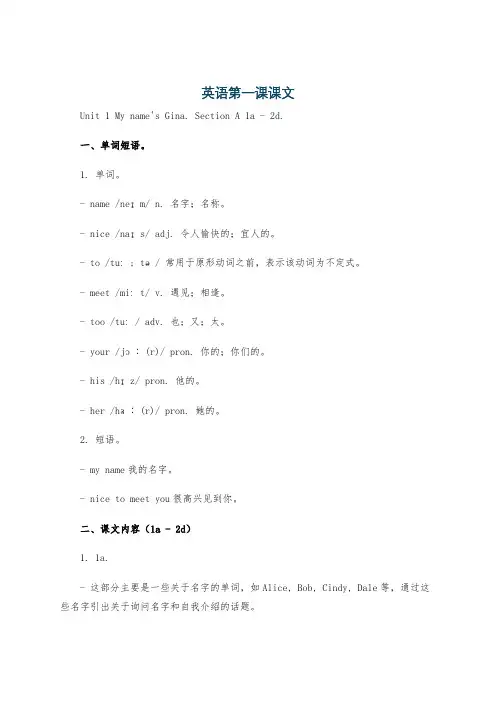
英语第一课课文Unit 1 My name's Gina. Section A 1a - 2d.一、单词短语。
1. 单词。
- name /neɪm/ n. 名字;名称。
- nice /naɪs/ adj. 令人愉快的;宜人的。
- to /tuː; tə/ 常用于原形动词之前,表示该动词为不定式。
- meet /miːt/ v. 遇见;相逢。
- too /tuː/ adv. 也;又;太。
- your /jɔː(r)/ pron. 你的;你们的。
- his /hɪz/ pron. 他的。
- her /hɜː(r)/ pron. 她的。
2. 短语。
- my name我的名字。
- nice to meet you很高兴见到你。
二、课文内容(1a - 2d)1. 1a.- 这部分主要是一些关于名字的单词,如Alice, Bob, Cindy, Dale等,通过这些名字引出关于询问名字和自我介绍的话题。
2. 1b.- 听力练习,听对话然后将名字与对应的人物匹配。
对话示例:- A: What's your name?- B: My name's Gina.- 这个对话简单地展示了如何询问名字和回答名字。
3. 1c.- 结对练习,仿照1b中的对话,用1a中的名字进行问答练习。
例如:- A: What's your name?- B: My name's Bob.4. 2a - 2b.- 2a是听力练习,听对话然后将名字与相应的描述匹配。
2b则是根据2a的听力内容填写名字。
对话中包含了更多关于名字和人物关系的表达,如:- A: Is he Jack?- B: No, he isn't. His name's Mike.5. 2c.- 这是一个角色扮演活动。
学生根据2a - 2b中的对话内容,进行角色扮演,练习询问名字和确认身份的表达。
6. 2d.- 对话示例:- Linda: Good afternoon! My name's Linda. Are you Helen?- Helen: Yes, I am. Nice to meet you, Linda.- Linda: Nice to meet you, too. What's your last name, Helen?- Helen: Miller. What's your last name?- Linda: Brown.- 在这个对话中,我们可以学习到下午的问候语(Good afternoon),自我介绍(My name's...),询问对方是否是某人(Are you...?),回答是的(Yes, I am.),以及询问姓氏(What's your last name?)等表达。
五年级英语第一课教案
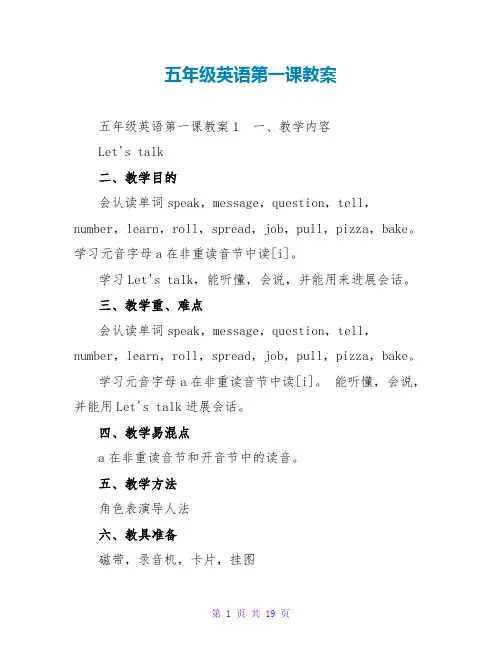
五年级英语第一课教案五年级英语第一课教案1 一、教学内容Let's talk二、教学目的会认读单词speak,message,question,tell,number,learn,roll,spread,job,pull,pizza,bake。
学习元音字母a在非重读音节中读[i]。
学习Let's talk,能听懂,会说,并能用来进展会话。
三、教学重、难点会认读单词speak,message,question,tell,number,learn,roll,spread,job,pull,pizza,bake。
学习元音字母a在非重读音节中读[i]。
能听懂,会说,并能用Let's talk进展会话。
四、教学易混点a在非重读音节和开音节中的读音。
五、教学方法角色表演导人法六、教具准备磁带,录音机,卡片,挂图七、教学过程【学习单词】学习speak,message,question,tell,number,learn,roll,spread,job,pull,pizza,bake等单词。
【导人新课】学习单词拼读规那么: 对本课个别单词的读音进展简单分析^p 并从中总结规律,通过分析^p 单词speak并联络eat,meat,tea,please,read等单词复习"ea母组合读[i:]";通过分析^p spread并联络head,bread,ready,dead,breakfast等单词复习"ea字母组合读[e]";通过分析^p 单词question学习tion读[t∫?n],如suggestion;通过分析^p tell,job复习元音字母e和o 在重读闭音节的读音,通过分析^p message并联络village,orange等单词学习元音字母a在非重读音节中读[i];通过分析^p 单词bake复习元音字母a在重读开音节中的读音。
B.导人对话:本课可用角色表演法导人。
大学英语第一册第一课
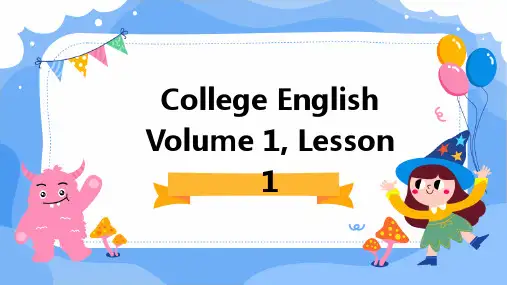
Critical Thinking
To develop students' analytical and critical thinking skills through discussions and debates on topics related to English language and culture.
Communication Skills
To improve students' ability to communicate effectively in English, both in formal and informal settings.
Course Outline
01
Unit 1: Language and Culture
The article also highlights important grammar points,
such as parallelism, subordination, and
modality.
These sentence structures and grammar points are used to enhance readability and to ensure that the message is clear and well-
Movie and TV dialogues
选取经典的电影和电视剧片段,让学生熟悉不同场景下的对话,提高 听力反应速度。
五年级上册英语单词第一课
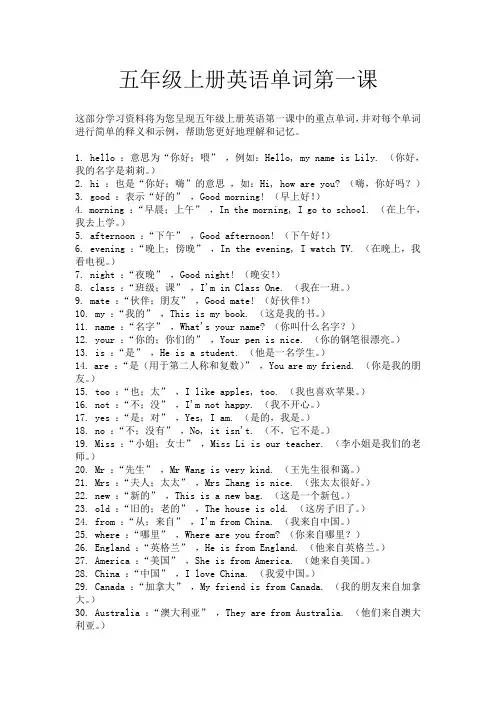
五年级上册英语单词第一课这部分学习资料将为您呈现五年级上册英语第一课中的重点单词,并对每个单词进行简单的释义和示例,帮助您更好地理解和记忆。
1. hello :意思为“你好;喂”,例如:Hello, my name is Lily. (你好,我的名字是莉莉。
)2. hi :也是“你好;嗨”的意思,如:Hi, how are you? (嗨,你好吗?)3. good :表示“好的”,Good morning! (早上好!)4. morning :“早晨;上午”,In the morning, I go to school. (在上午,我去上学。
)5. afternoon :“下午”,Good afternoon! (下午好!)6. evening :“晚上;傍晚”,In the evening, I watch TV. (在晚上,我看电视。
)7. night :“夜晚”,Good night! (晚安!)8. class :“班级;课”,I'm in Class One. (我在一班。
)9. mate :“伙伴;朋友”,Good mate! (好伙伴!)10. my :“我的”,This is my book. (这是我的书。
)11. name :“名字”,What's your name? (你叫什么名字?)12. your :“你的;你们的”,Your pen is nice. (你的钢笔很漂亮。
)13. is :“是”,He is a student. (他是一名学生。
)14. are :“是(用于第二人称和复数)”,You are my friend. (你是我的朋友。
)15. too :“也;太”,I like apples, too. (我也喜欢苹果。
)16. not :“不;没”,I'm not happy. (我不开心。
)17. yes :“是;对”,Yes, I am. (是的,我是。
六年级英语上册第一课
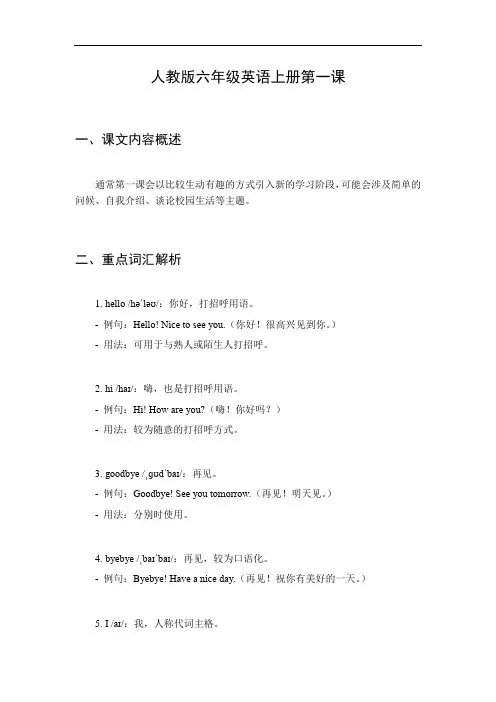
人教版六年级英语上册第一课一、课文内容概述通常第一课会以比较生动有趣的方式引入新的学习阶段,可能会涉及简单的问候、自我介绍、谈论校园生活等主题。
二、重点词汇解析1.hello /həˈləʊ/:你好,打招呼用语。
-例句:Hello! Nice to see you.(你好!很高兴见到你。
)-用法:可用于与熟人或陌生人打招呼。
2.hi /haɪ/:嗨,也是打招呼用语。
-例句:Hi! How are you?(嗨!你好吗?)-用法:较为随意的打招呼方式。
3.goodbye /ˌɡʊdˈbaɪ/:再见。
-例句:Goodbye! See you tomorrow.(再见!明天见。
)-用法:分别时使用。
4.byebye /ˌbaɪˈbaɪ/:再见,较为口语化。
-例句:Byebye! Have a nice day.(再见!祝你有美好的一天。
)5.I /aɪ/:我,人称代词主格。
-例句:I am a student.(我是一名学生。
)6.am /æm/:是,与“I”连用。
-例句:I am happy.(我很开心。
)7.you /juː/:你,你们,人称代词主格或宾格。
-例句:You are my friend.(你是我的朋友。
)8.are /ɑː(r)/:是,与“you”“we”“they”等连用。
-例句:You are beautiful.(你很漂亮。
)三、重点句型解析1.Hello! / Hi!-解析:简单的打招呼用语,用于引起对方注意并表示友好。
2.Goodbye! / Byebye!-解析:分别时的常用语。
3.I am...-解析:用于自我介绍,表达“我是……”。
4.You are...-解析:用于描述对方,表达“你是……”。
四、语法要点1. be 动词的用法:am/is/are 的基本用法。
- “I”用“am”,“you”用“are”,“is”用于第三人称单数。
五、学习建议1.多读多背:反复朗读课文和重点句子,增强语感。
英语语法第一课
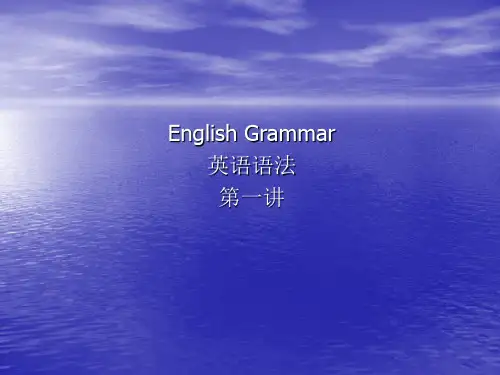
语的动作和状态的。
• 3.表语(predicative)它是放在连系动词之
后表示主语的身份或特征的。表语也就是 主语补语。补语(complement)分为主语补 语和宾语补语。
• 4.宾语(object)它是表示及物动词动作的
对象的。
• 5.定语(attribute)它是限定或修饰名词或
English Grammar 英语语法 第一讲
1.语法是什么? (What is grammar? )
• 语法是语言的组织规律, 它赋予语言以结构
系统。(the entire system of a language, including its syntax, morphology, semantics, and phonology)
• 7.冠词(article, 缩写为art.) 说明名词所指的
人或物的词。An article is a name for the (definite article) and a, an (indefinite
article).
• 8.介词(preposition,缩写为prep.) 表示名词
• 4.他是我的顶头上司。 • He is above me. • 5.微积分对我来说太难了。 • Calculus was always beyond me. • 6.你打这个电话就能找到我。 • You can reach me at this phone number.
4. How does that song go?
• 具体地讲, 主要有下列六种句子成分。
• 1. 主语(subject)它是句子所要说明的人
或事物, 是一句的主体。The subject is the part of the sentence that names whom or
高中英语第一课教案5篇
高中英语第一课教案5篇教学中,备课是一个必不可少、极其重要的环节,备课不充分或者备得不好,会严重影响课堂的气氛和学生的积极性,一堂准备充分的课,会令学生和老师都获益非浅。
因此,平时,我紧抓备、教、改、辅、查等教学中的重要环节。
以下是我带来的高中英语第一课教案内容,感谢您的阅读,希望能援助到您!高中英语第一课教案1Lesson Plan InterpretationNSEFC Book1 Unit3 Travel JournalHello, everyone. It’s an honor for me to stand here and interpret my lesson. The lesson plan I am going to talk about is from NSEFC Book 1 Unit 3 Travel Journal. I’ll explain how to teach and why do so from the following 5 aspects: the theoretical basis, understanding of the teaching material, teaching methods and studying ways, teaching procedure, blackboard design.Ⅰ. The theoretical basisFirst, I’d like to show my theoretical basis--schema theory and top-down model (Goodman, 1971). Journey down the Mekong is a reading course. According to schema theory, reading prehension is an interactive process between the reader’s background knowledge and the text (Carrel and Eisterhold, 1983), or between the new information and the old knowledge store (Anderson and Pearson, 1984). So in order to improve the students’ reading speed and reading prehension, language teachers should try to activate the Ss’ old knowledge store and add more relevant background knowledge before they get the students to read. According to the top-down model, general idea of the text will be got first, and then e the details.II. Understanding of the teaching materialMy understanding of the teaching material includes 3 parts: the status and the function, teaching objectives, the important and difficult points.At the beginning, let’s focus on the first part. Journey down the Mekong is a piece of travel journal written by Wang Kun. It’s mainly about Wang Kun and his sister’s dream of taking a great bike trip down the Mekong River, their preparation for the trip and some more details of the Mekong River. General speaking, it is not difficult for the students to understand thetext, but there are some new phrases and sentences that may be a little bit difficult. So before the students’ first reading, I will explain the new words and phrases briefly and after reading the whole passage, I will embody the usage of the news words and phrases, and get the student understand the difficult sentences. As it is a piece of journal, besides learning the new words and phrases, students can get the general idea of how to write a journal.That’s all for the first part, now let’s move to the second part. According to the teaching material and the new curriculum of English, in order to fulfill the learning task of this lesson, I establish the following objectives:a) Knowledge objectivesBy the end of the lesson, Ss will have a better understanding of the meaning and structure of the text. Then Ss will grasp some useful words and expressions such as determined, make up one’s mind, give in, be fond of …, care about…, stubborn, etc.b) Ability objectivesActually students should be encouraged to do speed reading in the first period of reading lesson. But the students in my class are lack of independent reading ability. In this class, Iwill encourage and help them to read, think and find out information by themselves most time. Since the main objective of reading course is to improve the Ss’ reading ability, I’ll train their ability of identifying the general idea in the fast reading. And in intensive reading their ability of information-gathering and summarizing is developed. And the whole class is for Ss to develop their reading skills as scanning, skimming, information-gathering, summarizing and guessing the new words from the text.c) Moral objectivesThough Journey down the Mekong is mainly about the trip down the river, it also talks about the scenery and life along the river. So before learning the text, we will have a short discussion about the importance of the river. I want the Ss to have the awareness of protecting the river and protecting our environment.Well, so much for the teaching objectives, lets e to deal with the third part: the important points and the difficult points. According to the national curriculum of English and language learning theory, when teaching reading, we should encourage the Ss to do speed reading for the first time, that’s to say, we should encourage our Ss to read as fast as they can when theydo the first reading. So much emphasis should be put on reading skills and reading prehension as well. So the important points are that how to make Ss grasp the new words and phrases and how to improve their reading skills as scanning, skimming, information-gathering and summarizing. As to the difficult points, they are the same as the important ones.III. Teaching methods and studying waysThat’s all for my understanding of the teaching material. Now let’s focus on the ways of teaching and learning.Generally speaking, I adopt task-based language teaching and municative approach in my class. As for learning, Ss will learn through independent reading, discussing and cooperating.I will use puter and blackboard as my teaching aids.Ⅰ. Teaching procedureHere es the most important part, the teaching procedure. It includes 5 steps: Step I: Lead-in andpre-reading, Step II: While-reading, Step III: Consolidation, Step IV: Post-reading, Step V: Homework.Step I: Lead-in and pre-reading (7mins)Now let’s e to the first step. There are three activities in this step and I will spend 7mins on them.In activity one, I will ask Ss two questions Do you know some great rivers in China? and Why they are great?” Here, asthe Ss get familiar with the Chinese great rivers, I choose to ask them some great rivers in China. And the answer to the second question can lead in the next activity--brainstorming.In activity two, I will ask the Ss to discuss in pairs and answer the question How do people who live along a river use it?” My purpose of this activity is to remind the Ss the importance of the river, thus stimulate the Ss awareness of protecting the rivers.In the last activity, I will show the Ss a picture of the Mekong River and ask them to list the countries that it flows through. This activity leads in the while-reading.Step II: While-reading (21mins)While-reading is the main part and it will take 21mins. Here I adopt the top-down reading model. This step is divided into 2 parts: fast reading and careful reading. Before reading, I will ask the Ss to predict what will talk in the text according to the title. It can exert the Ss imagination.1) Fast readingDuring fast reading, I will ask the Ss to reading the whole passage quickly and get the main idea of each paragraph. Usually, the main idea of each paragraph is the first sentence or the last sentence, but this text is not. So the main idea of eachparagraph will be matched because the Ss are lack of the skill of summarizing the main idea by themselves.2) Careful readingAfter getting the general idea of each Para., I will deal with the details Para. by Para..In paragraph one, I will ask the Ss to read quickly and do the exercises T or F. And if it is F, I will ask them to correct it. This exercise can help the Ss get the key information of the first paragraph in a short time and can deepen the Ss’ understanding of the first paragraph.In paragraph two, I will ask Ss one question “Is it a difficult journey to cycle along the Mekong? Why?” This can help the Ss develop their ability of summarizing. If the Ss can’t answer the question briefly, I will encourage them to find the key sentences and try to join them together.And in the last paragraph, I will ask Ss two questions “How does the water of Mekong River change?” and “What can you see when you travel along the Mekong River?” Both questions are required to answer in keys word. In order to lower the difficulty of the questions, I will show them the examples. After that, I will present some pictures to deepen the Ss’ impression on the new words. And these two questions can help the Ssgain a deeper understanding on the Mekong River.Step III: Consolidation (6mins)After dealing with the detailed information of each paragraph, I will ask the Ss to read the whole passage again and answer two questions to consolidate what they’ve learnt. It will take 6 minutes. The two questions are “Where is the source of the Mekong River and which sea does it enter?” and “How do Wang Kun and Wang Wei prepare for the trip?” It is easy for the Ss to find the answer to the first question in the text. As to the second question, it may be a little difficult, so I will list some tips for the Ss to find the answer more easily.Step IV: Post-reading (10mins)That’s all for the while-reading. Now let’s move to the fourth step. In this step, I will design two activities and I will spend 10 minutes on them.The first activity is filling in the blanks. In this activity, Ss are required to find the different attitudes of Wang Kun and Wang Wei to the trip, and then the teacher will express her attitude to this trip. After demonstrating, Ss are encouraged to express their attitudes. It can help the Ss train their ability of information-gathering and expression.The second activity is thinking. In this activity, I will ask theSs to discuss in groups of four and try to use some words to describe the characteristics of Wang Kun and Wang Wei according to their attitudes. It is really difficult, but it can not only train their ability of analysis and prehension, but also cultivate their spirit of cooperationStep V: Homework (1min)Finally it es to the homework. Ss are required to review the learnt lesson and underline the useful words and phrases in the text. This one is for them to consolidate what they’ve learnt and make preparation for the next lesson—Learning about the Language..Ⅰ. Blackboard designOn the top, there is the title of this lesson. On the left, it lists some important roles that the river plays. On the right, there are some useful words and expressions.That’s all for my interpretation. Thank you for your att高中英语第一课教案2一. 教材内容分析本单元的中心话题是“电影”,本课是第三课时,是一篇传记体的短文,介绍当前好莱坞最有影响的导演艺术家—史蒂芬斯皮尔伯格的创作生涯和一些作品。
The First Lesson——2024年初中英语开学第一课
hobby
age
I am xx years old.
name
My name is xxx. My English name is xxx.
I like ...
hobby
English is everywhere!
English is everywhere!
parking
Let's enjoy a song
An empty __s_tr_e_e_t_ An _e_m__p_ty__ house A hole inside my __h_e_a_rt
I'm all _a_l_o_n_e
The rooms are getting _s_m__al_le_r
I wonder _h_o_w__ I wonder _w__h_y_
26
I am 26 years old.
张三 Claire
My name is Zhang San. My English name is Claire.
I like listening to music and playing games.
music
game
Meet new friends
school
The rooms are getting smaller 房间越来越小了
I wonder how 我想知道怎么做 I wonder why 我想知道为什么
I wonder where they are 我想知道他们在哪儿
The days we had 我们曾经的日子
The songs we sang together 我们一起唱的歌
I wonder _w__h_e_rethey are The _d_a_y_s_ we had The _s_o_n_g_ we _s_a_n_g_ _to_g_e_t_h_er Oh yeah
英语开学第一课教案(7篇)
英语开学第一课教案(7篇)英语开学第一课教案精选篇1教学目标:知识与技能:能够听懂、会说、会认读单词:man, father, dad。
过程与方法:能够听懂、会说、会认读句型:who’s that man? he’s my father./ hi, dad.并能够在具体的语境中灵活运用。
情感态度与价值观:能够听懂指令,按照指令的要求完成point and say的内容。
教学重点:掌握三个单词和句子。
教学难点:能够理解和运用句型:who’s that man? he’s my father./ hi, dad.并能够听懂、会说、理解句子:this is my friend, amy.教学准备:照片,词卡教学过程:step1 warming up revisiona song” who is she?”(网络素材)。
a song “boy and girl”.’s chant:p8.my friends.引导学生介绍自己的朋友。
如:hi, i’m ’m from chin is my friend, ’s a ’s a ’s from china/ the uk/ canada/ the usa/ australia. step2 presentation practice1.以旧带新,学习新知(let’s talk)(1)教师:呈现mr jones,问:who’s he?引导学生答:he’s mr jones.教师:mr jones is a man.(2)学习单词man,并扩展woman对比进行学习。
2.词融于句,巩固新知活动1:呈现男教师的照片,让学生练说: mr… is a man.活动2:呈现男明星的照片,让学生练说:如yao ming is a man. and learn(1)呈现教师自己爸爸的照片:look, that is a ’s that man? can you gu?教师出示答案:he’s my father.(2)学习father,并扩展mother对比学习。
高中英语开学第一课学好英语课件PPT
ENGLISH FIRST CLASS
高中英语开学第一课
目录
01 Charm Of
English
英语的魅力
02
English Is Everywhere In Our Life
生活中英语无处不在
03
The Importance Of Learning English
学习英语的重要性
04 Suggestions
建议
PART
ONE
Charm Of English
英语的魅力
英语的魅力。
Charm Of English.
Learning a language is also learning a culture. 学习语言,也是在学习文化。
Language is used to understand a nation's habits, behavior, and perspective on the world. 通过语言了解一个民族的习惯、行为、看待世界的视角。
Stressed Desserts
强调甜点
PART
TWO
English Is Everywhere In Our Life
生活中英语无处不在
生活中英语无处不在。
English Is Everywhere In Our Life.
生活中英语无处不在。
English Is Everywhere In Our Life.
汉语:见字表意; 英语:见字表音。
启示:记单词时要注重发音,划分音节。
Chinese characters: hieroglyphic ideograms, emphasis on form rather than stress, the same characters behind various Chinese dialects, Hanyu Pinyin was officially implemented after the founding of the People's Republic of China.
- 1、下载文档前请自行甄别文档内容的完整性,平台不提供额外的编辑、内容补充、找答案等附加服务。
- 2、"仅部分预览"的文档,不可在线预览部分如存在完整性等问题,可反馈申请退款(可完整预览的文档不适用该条件!)。
- 3、如文档侵犯您的权益,请联系客服反馈,我们会尽快为您处理(人工客服工作时间:9:00-18:30)。
t
2、按时并高质量地完成作业,绝不拖拉!
3、每次作业都要用英文写日期 日期格式:写在开头,独占一行,右对齐。 Eg.1st,September.
认真是一种能力 优秀是一种习惯
七年级我们英语学什么呢?
U3Is this your pencil? U2This is my sister.
U1My name’s Gina. S3What color is it? S2What’s this in English? S1Good morning!
Let’s Let’s work work hard hard together! together!
只要我们一起努力,相信我们 一定会学好英语!
-Why are we learning English?
-Love English!!
小升初?中考?高考?大学? 工作?。。。。
• 英语是世界上使用最广泛的语言,是国际通 用语言之一。在国际政治、军事、经济、科 技、文化、贸易、交通、运输等领域,通常 以英语为交往工具。 • 60%广播节目 • 70%网页 • 80%以上国际会议
U5Do you have a soccer ball? U4Where is my school bag?
七 上 知 识 树
这学期你有怎样的目标?
你要怎样实现目标?
你离成功还有多远?
Attitude is everything! /'æ tɪtjuːd/
态度决定一切!
A=1 T=20 I=9 U=21 D=4 E=5
English in life 生活中的英语
Dove Dove德芙——巧克力,其实就是只鸽子。
Nestle雀巢咖啡——鸟窝。
Safeguard 舒肤佳——健康的卫士
Robust Robust乐百氏——其实是精力充沛的意思。
Rejoice
Rejoice飘柔——高兴,洗干净了肯定高兴。
Puma
Puma 彪马——美洲豹
Peak
Peak 匹克——顶峰,巅峰
秀是什么意思?
秀源于英文 show ,表示展示
Hold住姐
• hold住 • “hold住”就是指面对 各种状况都要控制把持 住,坚持,保持住,要 充满自信,从容地应对 一切。 • “要hold住”也有给力、 加油的意思。粤语中也 有注意、小心的意思
上课要求:
1、认真听讲,积极发言,英语课堂上尽量使用 英语进行讨论和回答问题,声音洪亮。
2、互相尊重,别人发言的时候认真倾听,积极 思考;互相鼓励:Enjoy losing face! 3、做好笔记,老师定期检查。
作业要求:
1、课后必须及时复习,多记单词,多背课文!老 师会用听写、课堂和课后抽背、小组比赛等的 方式考核。
A good beginning is half success.
一. 课前认真预习。 二. 课上认真听讲,做好课堂笔记,做到多管齐 下,五官并用,即眼看、耳听、脑想、口说、 手写,从而提高课堂效率。 三. 课后认真复习。学英语要做到“勤”字当头: 勤用心、勤记、勤练、勤问、勤归纳比较。 四. 课外认真独立完成作业。 五. 课堂作业上交及时,不能拖拉。
PK是什么意思?
在CS游戏引伸出来的名词 PK=Player Kill 毫无疑问,这个词最早出自游戏圈 儿,好多年前,玩泥巴的先辈们就已经 用文字互相厮杀,稍后的网络游戏里, 各色玩家们更把这个词用得滚瓜烂熟。 但是PK这个词大热却来自一档电视节目
Hale Waihona Puke 败东西是什么意思?败就是英语单词buy的音译, 因为汉语有败家子的说法, 所以败还有乱花钱的意思
Welcome back to school!
Welcome to my class !
赵艳妍 Miss Zhao
!
你 要 知 道 你 很 重 要 I’m very important! ︕
三点期待
学会感恩 :
感恩父母,兄弟姐妹,同学,老师和社会
简单生活: 今日一心苦读,只为明日一 鸣惊人 智慧引领幸福: 学习是为了将来能更幸福地活着 幸福在于生命的单纯和精神的丰富
How do we learn English?
英语课上的常用指令 The orders in our English class • 上课 class begins 下课 class is over • 起立 stand up 坐下sit down • 打开课本 open your books 合上课本close your books • 认真听讲 listen carefully • 把书翻到第几页 turn to page xx • 有没有同学主动回答这个问题 any volunteers?
A+T+T+I+T+U+D+E= ? 100
准备好以下学习用具
1、三个英语本。(作业本,听写本,练习本)
2、英汉笔记一本(语法,知识点)
3、红色笔。
Homework
• 1. 写一篇短文简要介绍自己及自己以前的 英语学习方法及自己英语情况(有能力的 同学可以用英语) • 2. 准备好:练习本,听写本,作业本,英 语笔记,红笔。 • 3. 预习26个英文字母。
• 在公共场合,英语随处 可见。厕所、路标、建 筑物、服饰类等标识! 如果你不了解这些常识, 你就不算是一个合格的 21世纪青年。
你准备好了吗
初中英语与小学英语
• 1.小学学英语要求简单,以听说读为主,初中 英语要求系统地学习,并对写提出较高要求。 • 2.小学英语内容简单,以背单词为主,而初中 英语内容复杂,词汇,句式,文章增多,语法 要求掌握。 • 3.小学考试以数学语文为主,初中考试英语成 为三大主科之一,与前者地位一样,分数一样, 在考试中占120分,至关重要。
